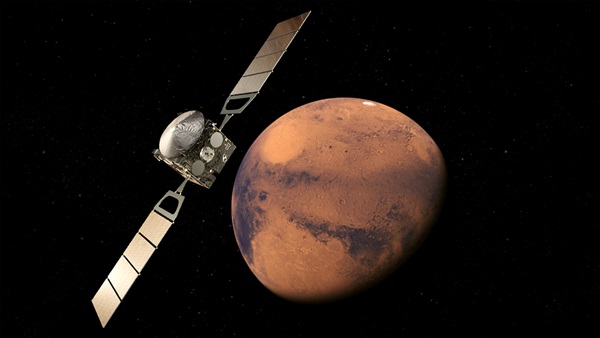One of a Kind Crater on Mars; Astronomers Discovered it Recently

The fourth planet from the Sun is quite a tough rock, but when something hits it, it
becomes like an artist’s canvas. Not long ago, in April this year, the astronomers
noticed a recent crater collision. MRO or otherwise known as the Mars
Reconnaissance Orbiter is the multipurpose spacecraft who identified the crater. The
blue and black fleck with large collision waves discerns itself in a fascinating way
from the red, powdery crust.
The mesmerizing, intense coloured spot pictured below was taken by HiRISE,
NASA’s High Resolution Imaging Science Experiment camera. At the time it took the
photograph, the device was orbiting at a distance of approximately 260 kilometers.
It’s not unusual for the Red Plane to be blitzed by asteroids and comets; it is said
that more than 200 comets and asteroids torpedo it every year and some of them
leave almost identical black marks or other stunning elements. Veronica Bray, a
planetary scientist at the University of Arizona told Space.com that this crater is one
of the most splendid ones she’s ever seen.
Only a handful of such celestial occurrences have been detected by the MRO in its
13 year old existence of Mars surveillance. Curious is the fact that even though the
asteroid bit that hit Mars is a tiny 1.5 metres wide (5 feet) thing, the crater is
significantly bigger, approximately 16 meters (up to 53 feet).
If this little bad guy had targeted Earth, the thick atmosphere would have almost
certainly destroyed it. These shooting rocks usually break into small pieces when
entering Mars’ atmosphere and they generate a series of craters, just like an
automatic gun would do.
In the case at hand, the rock must have been denser than the others, as the whole
space object banged onto a single spot in the Valles Marineris area, close to the
Martian equator.
The statement on the HiRISE website says that particular about this event is the
blackish matter that revealed itself from under the red surface.
Rightfully so, the collision marks can be seen very clearly. It shows a black area in
the center of the photograph with dislodged dust collections that bring out a surface
that is covered with rocks.
No one can tell for sure the exact physical features of this area, but Bray claims that
the part underneath is likely to be basalt. As for the blue in the photograph, she says
that it could ice that hid underneath the dust.
Even though they cannot say exactly when the impact took place, the scientists in
the field of astronomy estimate that it could have happened between September
2016 and February 2019.
0 comments